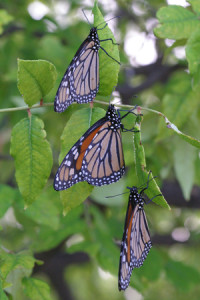Graceful and beautiful at the same time, the sight of a Monarch butterfly never fails to lift my heart. In Texas, Monarchs are harbingers of both spring and fall. In the spring, Monarchs are seen traveling north to exploit the emerging crop of milkweed plants favored by their caterpillars. In the fall, Texas serves as a flyway for southward migrating butterflies, as most of the U.S. eastern population of Monarchs heads toward their overwintering habitat in Michoacan State, in the Sierra Madre mountains west of Mexico City.
In recent years, however, numbers of Monarch butterflies have been in decline, leading many biologists to express grave concern for the survival of Monarchs in the eastern half of the United States. In hopes of supporting the beloved Monarch, many gardeners are choosing to include a few milkweed plants in their landscape plans. The idea is that by providing Monarchs with food plants in urban areas, we might be able to provide the butterfly population a boost, and increase their numbers throughout the warm season.
But not all milkweeds, it turns out, are equally good at sustaining Monarch caterpillars. Researchers at the University of Georgia have found that the year-round blooming tropical milkweed (Asclepias curassivica) , favored by many gardeners, may be harmful to the Monarch’s traditional migration patterns. It seems that one of the benefits of migration, as exhibited by the Monarch, is that it effectively weeds out weak or diseased individuals, while at the same time removing the population temporarily from local pathogens. Tropical milkweed encourages Monarchs to stay in one spot and form sedentary (non-migratory) populations.
Dara Satterfield and her colleagues used field and laboratory studies, along with citizen scientist observations to look at relative infection rates of sedentary vs. migratory populations of Monarchs. They concluded that widespread planting of tropical milkweed, which stays green through the winter months is leading to populations of monarchs that give up their migratory behavior. They also found that disease rates were higher in these “lazy” Monarchs.
It’s unclear whether such plantings have an overall negative or positive effect on the U.S. Monarch population; but if you’re considering planting milkweed in your backyard or as part of a conservation effort, it may be best to stick with one of the many native species. For a full copy of the report click here. For information from the Xerces Society about how to select and grow milkweed for conservation purposes, click here.
